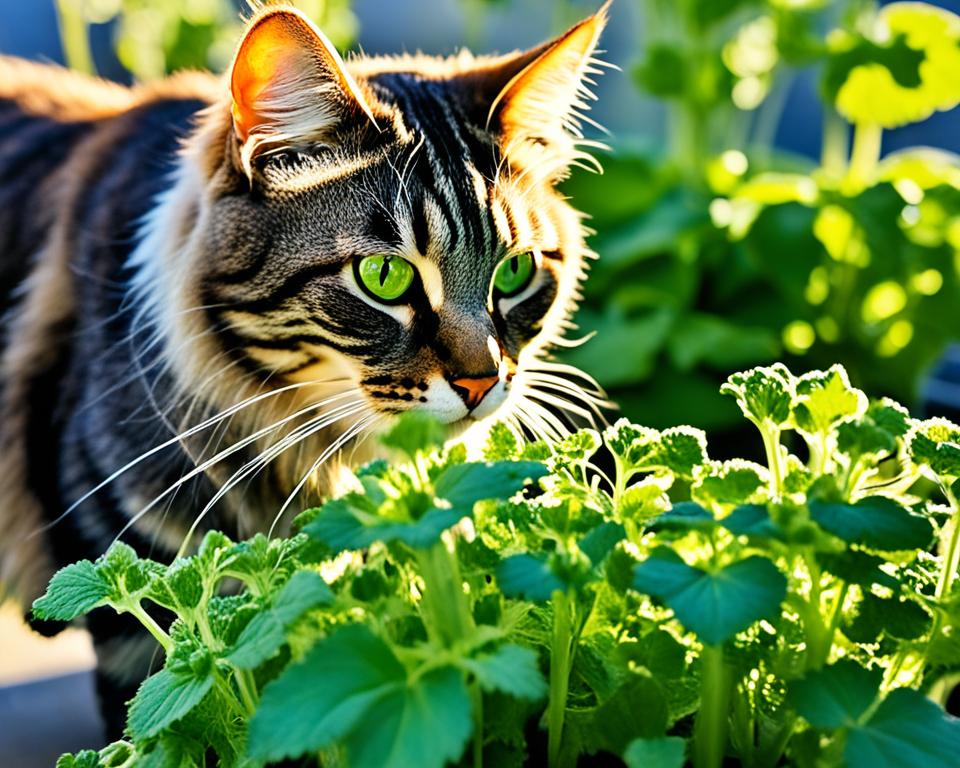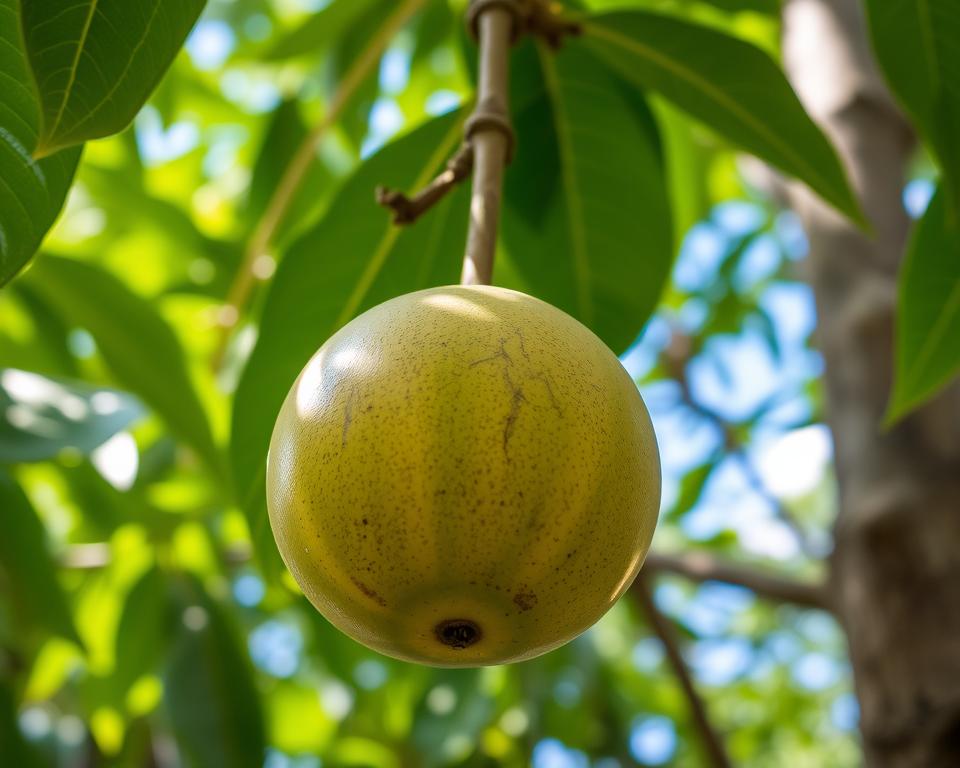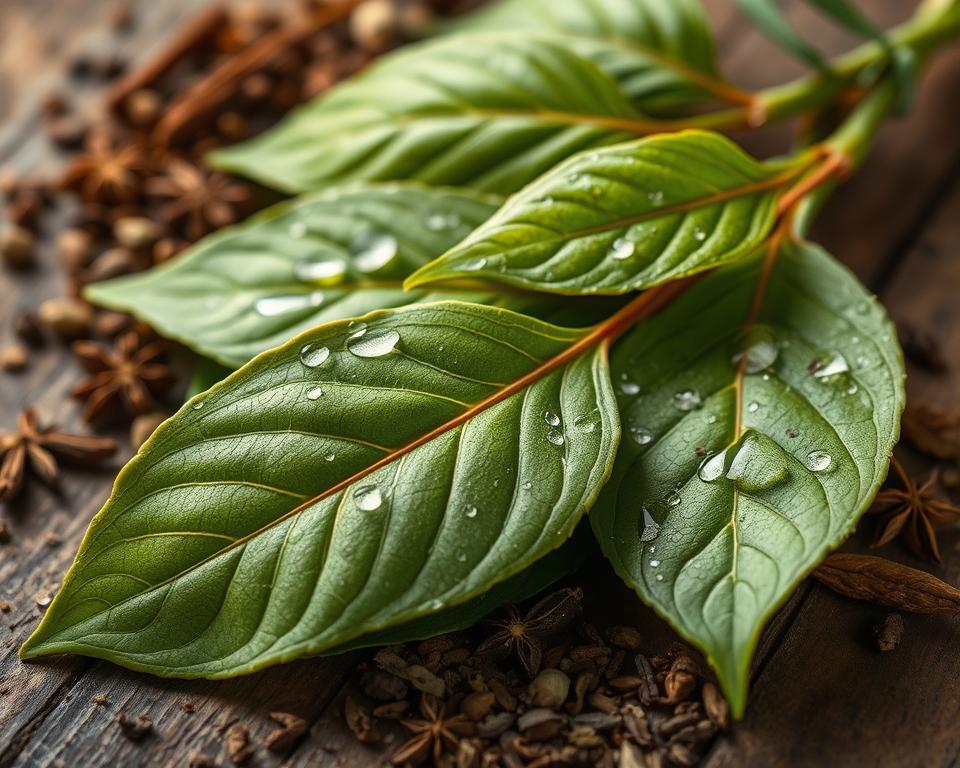Catnip is a special herb, known to botanists as Nepeta cataria or Cat Mint. It has amazed cat lovers for centuries. This plant has a strong appeal for cats. It causes them to act in interesting ways.
Our article will explore catnip’s history, what it is made of, and how it changes how cats behave and feel.
Read interesting things at : tosawakan
Key Takeaways
- Catnip is a member of the mint family and its active compound, nepetalactone, triggers a unique response in cats.
- Cats react to catnip by sniffing, licking, chewing, and rolling around, often displaying signs of euphoria and playfulness.
- The effects of catnip are temporary, lasting around 5-15 minutes, and cats need a break before they can experience the effects again.
- Catnip can be safely incorporated into a cat’s playtime, with proper consideration for age and health factors.
- While catnip may not interest all cats, it is a fun and popular addition to pet supplies and cat toys.
What is Catnip?
Catnip is a special herb known as Nepeta cataria. It’s a perennial, part of the mint family. Often called “cat mint,” it’s been enchanting cats for ages with its captivating effects.
Origins and Botanical Properties
Nepeta cataria comes from Europe and Asia. It’s a full, multi-branched plant that can reach three feet in height. The leaves are heart-shaped, green, and a bit fuzzy. Its small flowers come in white or pink clusters in the summer. What really grabs a cat’s attention is its minty-citrus smell.
Catnip’s Unique Aroma
Its alluring scent comes from a compound called nepetalactone. This compound is in the leaves, stems, and flowers, making cats go crazy for it. When cats sniff nepetalactone, it lights up their brain, giving them the “catnip high” we all know.
“The captivating scent of Nepeta cataria is attributed to the presence of a chemical compound called nepetalactone.”
It’s key to know cat mint‘s background to get why it affects cats so much. The plant’s taxonomy and its scent make it a key part of the cat world. From where it grows to how it smells, catnip is truly captivating.
How Catnip Affects Cats
Catnip is known for making cats go wild. It triggers a special response in cats’ brains. This makes them act in fascinating ways, which many pet owners find interesting.
When cats smell catnip, it starts a chain reaction in their brain. This can make them either playful, relaxed, or just happy.
- They may sniff and lick the catnip, feeling joyful.
- They might rub their face and body on it, enjoying the scent.
- Some will act super excited, rolling and jumping around.
- They could make happy sounds, showing their pleasure.
- Others might get really calm, almost falling asleep.
How they react varies a lot. It depends on their own genetic traits. Some may love it, while others won’t care at all.
“Catnip’s ability to affect cats in so many ways shows how complex their biology is. The link between nature and catnip’s chemicals is amazing.”
Knowing how catnip works is key. It can help us better understand our cats. This insight can make our bond stronger and help us meet their needs.
The Chemistry Behind Catnip’s Appeal
Catnip’s allure on cats isn’t just a simple thing. It gives us a peek into how plants and animals can interact in amazing ways. A key player in this is a special chemical called nepetalactone. This compound is what makes catnip irresistible to our feline friends.
Nepetalactone: The Active Compound
Nepetalactone is a special compound found in catnip’s leaves and stems. It’s what causes cats to have a wild and fun reaction. This compound smells to cats, making them act in funny ways, from rolling in it to sitting still and staring.
Even a tiny bit of nepetalactone can make a cat act crazy. The amount of this compound in catnip varies. That’s why some cats go crazy for it, while others might not care much.
Feline Genetics and Sensitivity
Every cat is not equally drawn to catnip’s magic. This is because of their genes. A gene called Fel d 4 decides if a cat can smell and react to nepetalactone.
Cats with the Fel d 4 gene often show playful or calming behaviors when near catnip. Those without the gene might not even notice catnip. So, it’s all about genetics.
Knowing about catnip’s chemistry and how cats respond can be useful for pet owners. It helps us understand our cats better. This knowledge lets cat owners cater to their cat’s need for fun and stimulation.
Safe Usage of Catnip
It’s important to be careful when giving your cat cat toys, cat treats, and other pet supplies with catnip. Catnip is safe for cats, but you need to be cautious.
Age and Health Considerations
Don’t give catnip to kittens under 3-6 months. They are very sensitive to nepetalactone, the active compound. Cats with heart or lung problems should also avoid catnip. Always ask your vet before giving catnip to a cat with health problems.
For adult cats in good health, use catnip moderately. Too much can overstimulate them. Start with a small pinch to see how your cat reacts.
Catnip’s effects last 5-15 minutes. After that, it won’t work on your cat for hours. Don’t give them more catnip during this break time.
“Catnip is a safe and natural way to enrich your cat’s life, but it’s crucial to use it responsibly and in moderation to ensure your feline friend’s well-being.”
Stick to these tips for using catnip safely. This way, you can add catnip cat toys, cat treats, and other pet supplies to your cat’s life safely.
Catnip for Enrichment and Playtime
Catnip enriches a cat’s play and life. Adding it to items like cat toys and cat treats boosts mental well-being. It sparks natural behaviors, making play more fun and engaging.
Using catnip on cat toys is a smart move. A little pinch makes toys irresistible to cats. They’re drawn in to play, fulfilling their hunting instincts. This not only fights boredom but also promotes mental health.
Catnip can spice up cat treats too. You can use them to train your cat or as a fun snack. It’s a great way to keep your cat active and exploring.
- Catnip-infused toys can stimulate a cat’s natural prey drive and alleviate boredom.
- Catnip-enhanced treats can be used as rewards for training or as a special snack.
- Interactive activities like hide-and-seek or puzzle feeders can provide mental stimulation and satisfy a cat’s innate curiosity.
There are more ways to use catnip than just with toys and treats. Try hiding catnip around the house for your cat to find. Or use puzzle feeders that require them to work for their treats. These are fun, engaging ways for cats to play.
“Catnip is a versatile tool that can help pet owners create an enriching environment for their feline friends, promoting both physical and mental well-being.”
Catnip offers endless play opportunities for cats. With toys, treats, or fun games, catnip is a must-have. It keeps cats happy and engaged, creating a life full of play.
Growing Your Own Catnip
If you love cats, growing your own catnip is not just fun but also enjoyable. Catnip, or cat mint, is a fragrant herb that attracts your pets. It lets you control the plant’s quality and amount.
Planting and Harvesting Tips
Here is how to grow catnip. It loves well-drained soil and lots of sun. Plant it in a warm, protected place. Remember to water it often.
To make your catnip plants full and healthy, cut the stems often. This step makes the plant look neat. It also helps it produce the oils that cats love.
Harvest catnip when the plants bloom in summer. Cut the leaves and stems near the soil. Dry them by hanging in a cool, dry place. Then, you can use it for your pets.
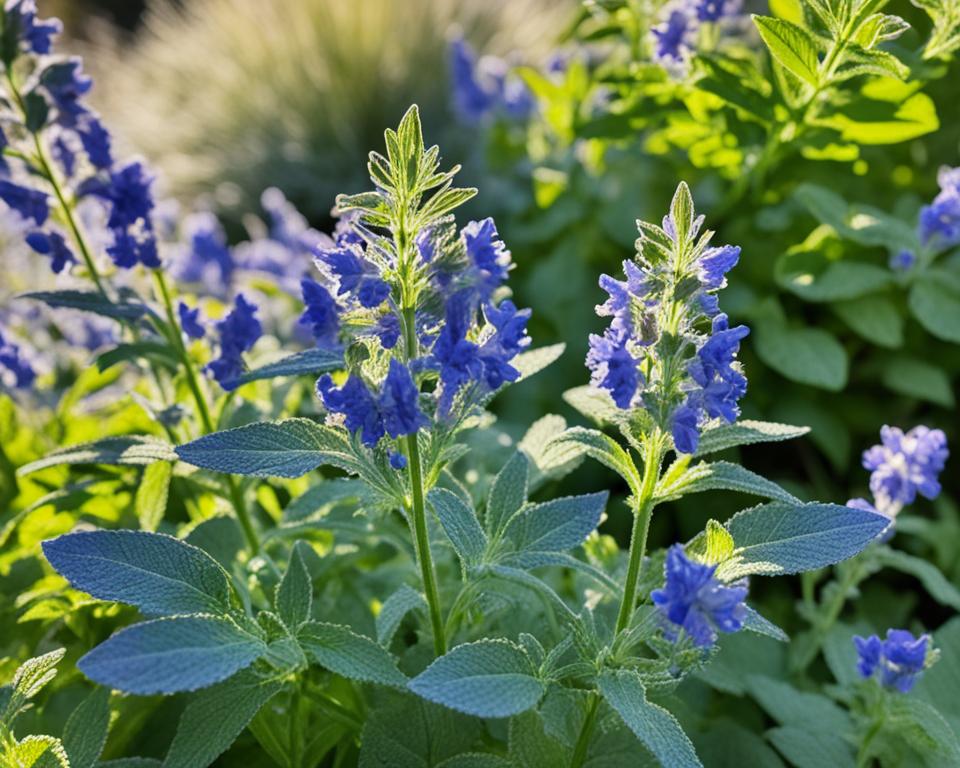
Follow these steps for a lot of fresh catnip. Your cats will enjoy it a lot. From a small spot to a full garden, it’s both fun and rewarding.
| Catnip Planting Guide | Catnip Harvesting Guide |
|---|---|
|
|
“Growing your own nepeta cataria is a great way to provide a sustainable, high-quality source of catnip for your feline friends.”
Catnip Toys and Treats
Cats love catnip, and its use has branched out from the plant itself. Pet owners have found a range of cat toys and cat treats. They’re infused with catnip to fulfill their pets’ unique wants. These products provide a fun way to interact with and captivate cats. They also help stimulate their minds.
Catnip toys come in many types. This includes interactive balls, scratching posts, and soft toys. They’re all scented with catnip. When a cat plays with them, the catnip’s scent kicks in. This often results in a cat becoming more playful and lively. These toys are great because they fulfill a cat’s natural needs to explore, play, and hunt.
Catnip cat treats are another favorite. They are made in various shapes, sizes, and flavors. From crispy treats to chewy bites, there’s something every cat will love. These treats are not just for fun. They can be handy in training, offering rewards, or as an occasional snack.
| Product | Description | Benefits |
|---|---|---|
| Catnip-Filled Toy Ball | A durable, interactive ball filled with premium catnip, designed to encourage active play and exploration. | Promotes physical and mental stimulation, satisfies a cat’s natural hunting instincts, and can be used for training or rewards. |
| Catnip-Infused Scratching Pad | A scratch-resistant pad made with natural catnip, providing a designated area for cats to scratch and indulge their scent-marking behaviors. | Helps redirect scratching behavior from furniture, protects household surfaces, and encourages natural scratching habits. |
| Catnip Treats | Bite-sized, crunchy or soft-baked treats made with high-quality catnip, offering a delightful and rewarding snack for cats. | Can be used for positive reinforcement during training, as a special treat, or as a way to bond with your feline companion. |
Adding catnip toys and treats can make a cat’s life more fun and stimulating. These products are helpful for engaging in play, taking care of their claws, and treating them to something tasty. Thus, they play a key role in keeping your cat happy and healthy.
Catnip Alternatives
While catnip is a top choice for many pet owners, it’s not the only option. Pet lovers can look into other natural scents and textures to keep their cats entertained. These extras could be just as fun as catnip, offering a new kind of playtime.
Other Natural Feline Attractants
Besides catnip, there are other nature-based items that cats love. These can give your cat a varied play experience. It helps make their surroundings more interesting and enjoyable.
- Valerian Root: This herb relaxes people but perks up cats instead, making them playful.
- Silver Vine: It’s like catnip, with a scent that drives cats to fun and games.
- Honeysuckle: Cats enjoy its smell so much, they start rubbing and licking it.
- Nepeta Cataria Var. Citriodora: Lemon catnip adds a fresh twist some cats simply adore.
By mixing these cat nip and cat stimulant options together, pet owners can add excitement to their cat’s life. It’s a great way to make their space more engaging and fun.
| Natural Feline Attractant | Potential Benefits | Considerations |
|---|---|---|
| Valerian Root | Can make cats more active and playful | Can cause too much excitement in some cats |
| Silver Vine | Similar to catnip in how it excites cats | Not as easy to find as catnip |
| Honeysuckle | Attracts cats with its sweet fragrance | It might be harmful if cats eat it |
| Nepeta Cataria Var. Citriodora | Has a fruity scent that some cats love | Not all cats are interested in it |
“Enriching a cat’s environment with a variety of natural stimulants can help satisfy their instinctual behaviors and promote overall wellbeing.”
Looking into these alternative cat nip choices can make playtime more fun for your cat. They offer a wonderful change from the usual catnip.
Catnip’s Role in Feline Behavior Studies
Catnip is a big deal in studying why cats act the way they do. Scientists and researchers find it very interesting. They use catnip to learn about what makes cats tick.
This herb helps us look into many cat behaviors. These include how they interact with others, mark their territory, and have fun. Watching cats with catnip sheds light on how they think and what drives their actions.
Investigating Feline Social Dynamics
Catnip also plays a part in how cats get along with each other. With catnip around, cats might play more, hang out with others, and mark their spots differently. This has shown us a lot about cat friendships and pecking orders.
Uncovering Innate Instincts
Catnip isn’t just about social stuff. It helps us see what instincts cats are born with. When cats sniff catnip, it shows us what’s going on in their brains and bodies. We learn about what makes them curious, excited, and ready to hunt.
| Behavioral Aspect | Catnip’s Contribution to Research |
|---|---|
| Social Dynamics | Insights into feline social hierarchies, communication, and territorial behavior |
| Innate Instincts | Understanding the neurological and hormonal underpinnings of feline behaviors, such as arousal, curiosity, and predatory tendencies |
| Cognitive Development | Exploring the role of cat stimulant properties in feline cognitive development and learning |
As scientists keep looking, catnip stays a key part of their studies. It’s an important way to learn more about our cat friends. Understanding catnip helps us understand cats better.
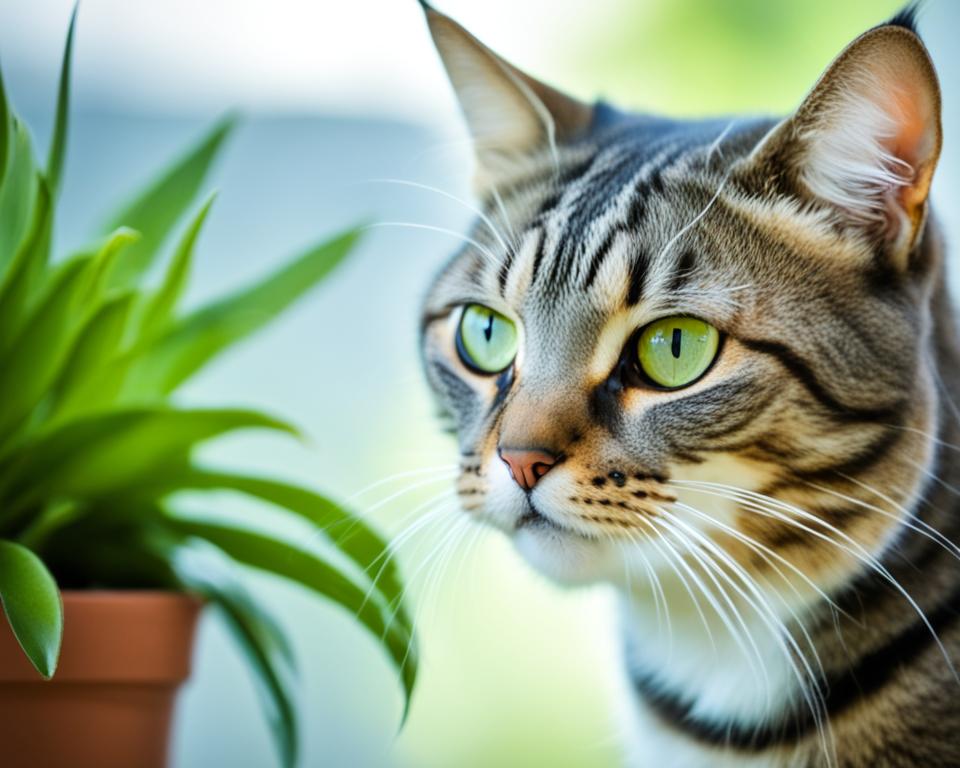
“Catnip has proven to be a powerful catalyst in our efforts to understand the intricate workings of the feline mind. Its unique properties have unlocked a wealth of insights that continue to shape our knowledge of cat behavior and psychology.”
Cultural and Historical Perspectives
The plant known as cat mint or cat nip is very special in history and many cultures. It has been adored for ages, from ancient times to today’s cat lovers. People all over the world find it fascinating.
In ancient Egypt, cat nip was very important. They linked it with the goddess Bastet, who protected cats. The Egyptians thought it was mystical and used it in their ceremonies. In Greece, they saw cat mint as a sign of welcoming guests in their homes.
“The ancient Egyptians believed that cat nip had powerful magical properties and associated it with the cat goddess Bastet.”
In the Middle Ages of Europe, cat nip was seen as a way to keep evil away and to bring joy in the house. Some communities believed putting it with dead pets would keep them happy in the next world.
- In ancient China, cat nip was in medicinal use for its calming effects.
- American tribes like the Cheyenne and Arapaho used cat mint in their spiritual rituals.
- Today, cat nip is a favorite among cats, bringing fun and calmness.
The lasting interest in cat nip shows our strong link with cats. This special plant continues to attract and inspire us. It reminds us of the ageless friendship between humans and cats.
Catnip for Humans?
Catnip is famous for fascinating cats, but some wonder about its benefits for us humans. Both scientific studies and personal stories point to interesting uses for catnip. This makes its potential for human use quite captivating.
The key compound in catnip is nepetalactone. It has grabbed attention in studies for its possible health effects. Research hints it might help with calming, easing anxiety, and even boosting moods in people.
But, the impact on humans is much milder than what cats experience. People might just feel a bit more relaxed or see things a little differently. They do not usually have strong, trippy reactions.
Some folks say they use catnip to help with stress, anxiety, or sleep issues. But, whether it really works for us isn’t clear yet. Scientists need to do more studies to figure this out.
Also, check if catnip is okay where you live. Its legal status can differ from place to place. In many areas, though, using catnip is fine. Still, it’s best to know the rules before giving it a try.
In the end, while the idea of catnip for people is interesting, we’re still learning about it. Not enough is known to confirm its medical value or safety. For now, it’s mainly a fun plant for our beloved pets.
Conclusion
We’ve discovered how catnip brings joy to our cats. It comes from plants and has a special chemical that cats love. This makes it great for our pets and for us, too.
To use catnip well, we need to be careful. We think about things like how old our cat is and if they’re healthy. This way, they get all the good stuff from catnip without any risks. The study of catnip is growing, which shows how important it is for pet care.
Catnip isn’t just for fun games. It’s a way to bond with our cats. This guide helps us understand the catnip and cat connection. It offers many tips for a happy, enriched cat life.






